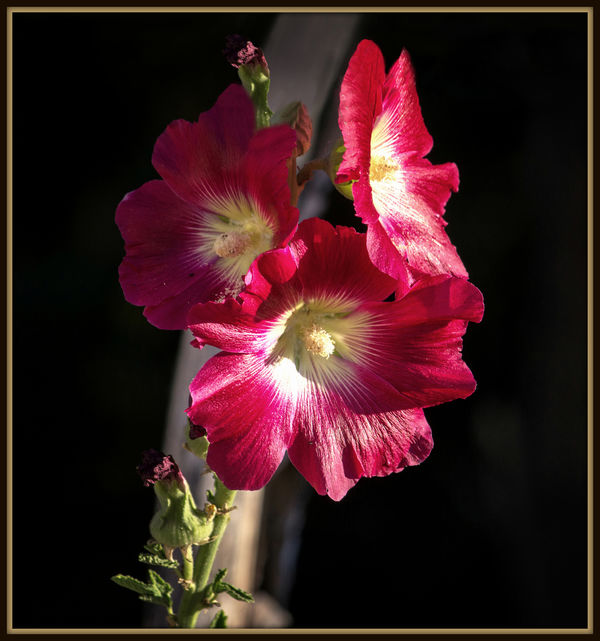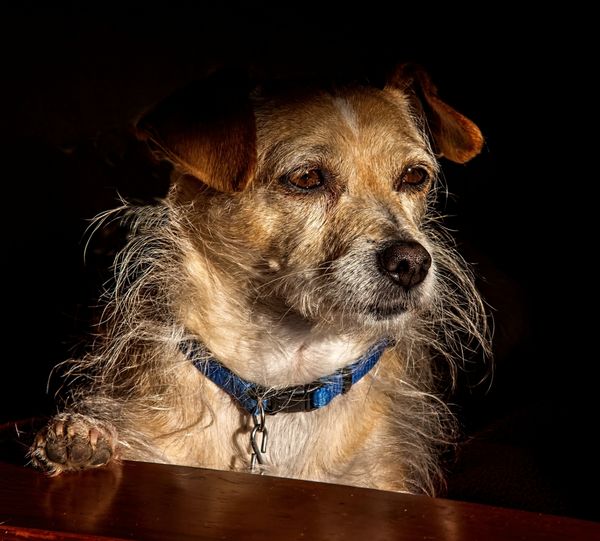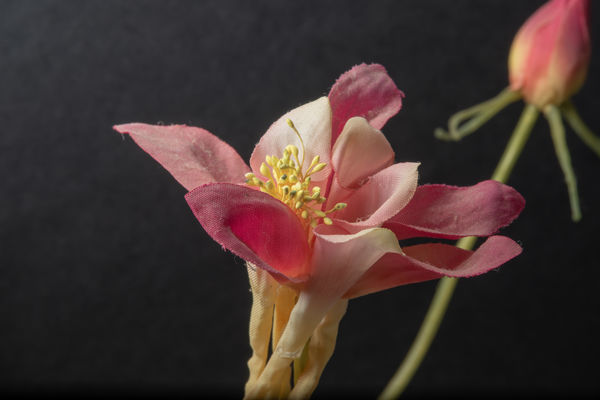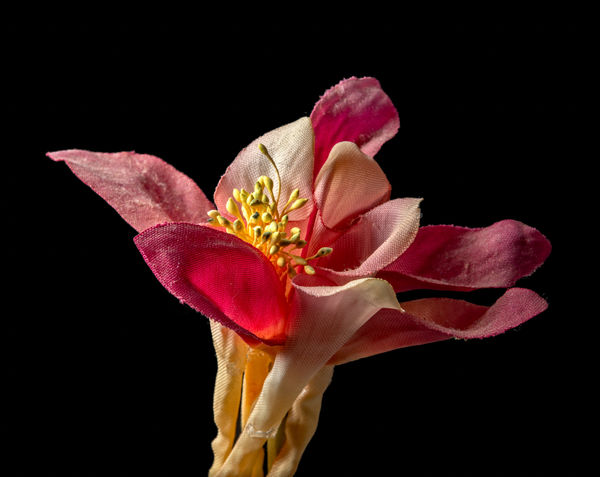Background Control
Feb 15, 2019 16:00:45 #
I'm working on background control. Many pics posted here (& everywhere) have a 100% black background. Right now I'm shooting outdoors, on static subjects, & I can sometimes blur out a background, if I can get in close, by stopping aperture down to around f/16 then adjusting shutter speed (& ISO if necessary) for good exposure; but so far nothing close to "all black". Also if I use max zoom to get tighter to the subject the resulting images can look flat & grainy without much subject isolation. At this stage I want to achieve as dark as possible in camera. I figure if I can do that whenever I want, I can get any amount of bokeh, or subject isolation I want, for any shot.
I've been searching posts but haven't pieced it together yet. Some posts mention using f/16 or higher to black out a background. Some posts mention using shutter speed to do this (but no specifics). Some posts mention diffraction countering depth of field effects at apertures above f/11. Some tutorials I've read on this topic seem aimed at studio work.
I have a D7200; Nikkor 18-140 & 70-300 VR's; Sigma 17-70 & Tokina 11-16. So far I've only tried this effect with the 2 Nikkor lenses as I have no hoods for the other 2 (& limited lighting for shooting indoors).
Is there a straightforward approach to crisply isolating a static subject, outdoors, with a black or quite dark background (including indoor vs. outdoor)?
I've been searching posts but haven't pieced it together yet. Some posts mention using f/16 or higher to black out a background. Some posts mention using shutter speed to do this (but no specifics). Some posts mention diffraction countering depth of field effects at apertures above f/11. Some tutorials I've read on this topic seem aimed at studio work.
I have a D7200; Nikkor 18-140 & 70-300 VR's; Sigma 17-70 & Tokina 11-16. So far I've only tried this effect with the 2 Nikkor lenses as I have no hoods for the other 2 (& limited lighting for shooting indoors).
Is there a straightforward approach to crisply isolating a static subject, outdoors, with a black or quite dark background (including indoor vs. outdoor)?
Feb 15, 2019 16:06:26 #
The aperture and shutter speed numbers don't matter specifically; it's simply your overall exposure and light source. What kinds of subjects do you want to isolate via a dark background?
Bokeh and background blurring is a separate discussion (and dependent on the lens and the aperture setting, among other considerations).
Shooting subjects that are sunlit while backgrounds are in shadow will make it much easier (as will shooting in raw for additional adjustments of blacks) - one of the many reasons I prefer early morning photography
.
Bokeh and background blurring is a separate discussion (and dependent on the lens and the aperture setting, among other considerations).
Shooting subjects that are sunlit while backgrounds are in shadow will make it much easier (as will shooting in raw for additional adjustments of blacks) - one of the many reasons I prefer early morning photography

.
Deeply shadowed woods behind this garden. Spot meter on the flowers, not the overall scene.

INDOORS. No flash; the sun was low angle and shining directly on my pup :)

(Download)
Feb 15, 2019 16:16:59 #
I sometimes use a flash on flowers and the farther away the background is the darker it gets.
Feb 15, 2019 16:18:54 #
Flash can help achieve a black or near black background in daylight. Here is an interesting article mentioning several techniques to achieve what you wish. https://www.naturescapes.net/articles/techniques/avoiding-black-backgrounds-for-macro-photography/
Enjoy
Enjoy

Feb 15, 2019 16:19:40 #
BassmanBruce wrote:
I sometimes use a flash on flowers and the farther away the background is the darker it gets.
We must have posted at the same time.

Feb 15, 2019 17:03:29 #
Linda's photos above are perfect examples of having a well lit subject in front of a dark background as a way of accomplishing what you are trying to do. A good way might be shooting a subject when you have bright beams of sunlight coming into a window when the rest of the room is dark. And carefully spot metering off that subject is also important. Bear in mind the examples you are seeing may be done in editing, or also by taking dark paper or cloth and placing it behind the subject.
F/16 really has little to do with it, and it will less likely decouple the background from the subject unless you're are very close to the subject. It's wide apertures that will do that. The only time the shutter will play a role in darkening the background is when you are using flash. With flash photography there will be two light sources that will influence the final exposure, the microburst of flash, and the ambient light, and the shutter will control the amount of ambient light. So a fast shutter will kill the ambient light therefore making the background dark and your flash will be the primary light source for the subject. Remember, with flash, your shutter speed selection will be limited to the camera's sync speed, say 1/200 second. High speed sync can be used as long as you have a camera and speedlight that supports it. Then, you can shoot at very fast shutter speeds of say 1/1000 second giving you a much better chance of killing the ambient light...but this is a subject for another day.
F/16 really has little to do with it, and it will less likely decouple the background from the subject unless you're are very close to the subject. It's wide apertures that will do that. The only time the shutter will play a role in darkening the background is when you are using flash. With flash photography there will be two light sources that will influence the final exposure, the microburst of flash, and the ambient light, and the shutter will control the amount of ambient light. So a fast shutter will kill the ambient light therefore making the background dark and your flash will be the primary light source for the subject. Remember, with flash, your shutter speed selection will be limited to the camera's sync speed, say 1/200 second. High speed sync can be used as long as you have a camera and speedlight that supports it. Then, you can shoot at very fast shutter speeds of say 1/1000 second giving you a much better chance of killing the ambient light...but this is a subject for another day.
Feb 15, 2019 23:46:42 #
Linda From Maine wrote:
The aperture and shutter speed numbers don't matte... (show quote)
Hi Linda, thanks & super pics! I'm shooting ice sheets, little trees & plants & things in the boat yard.
I can control bokeh a little, for instance, if I frame a little sunlit sitka spruce seedling (close up) against dark trees in the background, I can blur out the foreground & the background trees, but I was hoping to get the treed area behind the subject quite dark as a natural contrast to the brightly lit little seedling. I get blurry dark-ish green but not really black or near black.
I have been shooting at 100-200 ISO for shadow clarity with shutter speed usually at 250 due to shooting hand held in below freezing temps. If I can find something solid to set the camera on I try reducing shutter speed & opening up the aperture for better bokeh. Is that an OK approach or am I on the wrong track?
Good news is the light is coming back up here - 4 hours of usable sunlight now! Great news is I am getting some shots I like using Manual. Like you & others keep saying, sticking with it is more than worth it.
I'll post some shots once I know how to copyright them: I had some of my best shots taken & used to make buttons & post cards; stupid me for posting them.
Thanks as always, Dione, Alaska
Feb 15, 2019 23:49:22 #
autofocus wrote:
Linda's photos above are perfect examples of havin... (show quote)
Hey Autofocus - great post; thanks so much. I've saved this info for when I can set up to shoot indoors as I believe the D7200 does support high speed sync flash (though I have no off-camera lighting gear yet - pretty much a novice!).
Feb 15, 2019 23:50:48 #
Bmac wrote:
Flash can help achieve a black or near black background in daylight. Here is an interesting article mentioning several techniques to achieve what you wish. https://www.naturescapes.net/articles/techniques/avoiding-black-backgrounds-for-macro-photography/
Enjoy
Enjoy

Hi Mmac - this is a super read; thanks so much for your post!
Feb 16, 2019 07:04:56 #
dione961 wrote:
I'm working on background control. Many pics post... (show quote)
There is a someone named Snap Shot on this site. He/she seems to have the best pictures for what you are looking for.
Feb 16, 2019 07:30:24 #
dione961 wrote:
I'm working on background control. Many pics post... (show quote)
I did a macro workshop at a local photo club. There are two keys to accomplishing what you are after. The first and most important key is lighting. If there is light on the background you'll see it. F16 or smaller is going to have zero effect on the background, other than the fact it will be better defined because of the greater depth of field that F16 provides.
When I do flowers and other small subjects, I use a large bounce card (10x14) and an off-camera speedlight at 1/16 power, but the bounce card is just inches away and the light is angled to "flag" any light from landing on background elements. That will get you to 80%-90% of a black background.
The other key is post processing. you create a mask of the flower - include the flower and exclude the background. Then add a fill layer of back beneath the flower-only layer and voila! you have exactly what you are after! BTW, a black fill layer is one the most consistent ways of having a completely black background.
Feb 16, 2019 08:27:28 #
dione961 wrote:
Hey Autofocus - great post; thanks so much. I've saved this info for when I can set up to shoot indoors as I believe the D7200 does support high speed sync flash (though I have no off-camera lighting gear yet - pretty much a novice!).
Understand what you are trying to achieve is very difficult. Without a speedlight the ambient light conditions would have to be perfect to get something close to what you want. With the way exposure works you cannot darken the background without darkening the subject too, and/or vice/versa for lightening. Yes, your D7200 will do high speed sync, but you will also want a speedlight that supports it (not sure you can do that with the on camera flash, and if using a larger lens, the lens will cast a shadow on your image when using the on camera flash)
Feb 16, 2019 08:43:20 #
dione961 wrote:
Bokeh is defined as the quality of the out of focus area. I remember Gene51 posting 3 photos awhile back to show comparisons (good, bad, neutral). All relate to how the background interacts with, enhances or distracts from your subject.I can control bokeh a little, for instance, if I frame a little sunlit sitka spruce seedling (close up) against dark trees in the background, I can blur out the foreground & the background trees, but I was hoping to get the treed area behind the subject quite dark as a natural contrast to the brightly lit little seedling. I get blurry dark-ish green but not really black or near black.
For the most part, you are going to be concerned simply with depth of field, and yes - that is controlled by aperture. But also focal length and distance. See:
http://www.dofmaster.com/dofjs.html
Back to black backgrounds, if your seedling and the background are equally lit, you will be limited. In this thread, Gene mentioned achieving your pure black background via pp if you aren't able to use the proper flash equipment or if natural light isn't cooperating. Is there a time of day when the background is in shadow? (glad you are actually having some sun now
 )
)Feb 16, 2019 09:30:35 #
autofocus wrote:
Understand what you are trying to achieve is very ... (show quote)
It's really not hard to do at all. Later this evening I will post an image with a busy background that was not taken with a speedlight and I spent a couple of minutes masking the subject and replacing the background with black
Feb 16, 2019 09:59:37 #
Gene51 wrote:
It's really not hard to do at all. Later this evening I will post an image with a busy background that was not taken with a speedlight and I spent a couple of minutes masking the subject and replacing the background with black
Of course you can do that in editing, but the op is a novice shooter, and possibly does not yet have the skills to do layers and masks. It seems he/she wants the look achieved by mostly SOOC
If you want to reply, then register here. Registration is free and your account is created instantly, so you can post right away.







